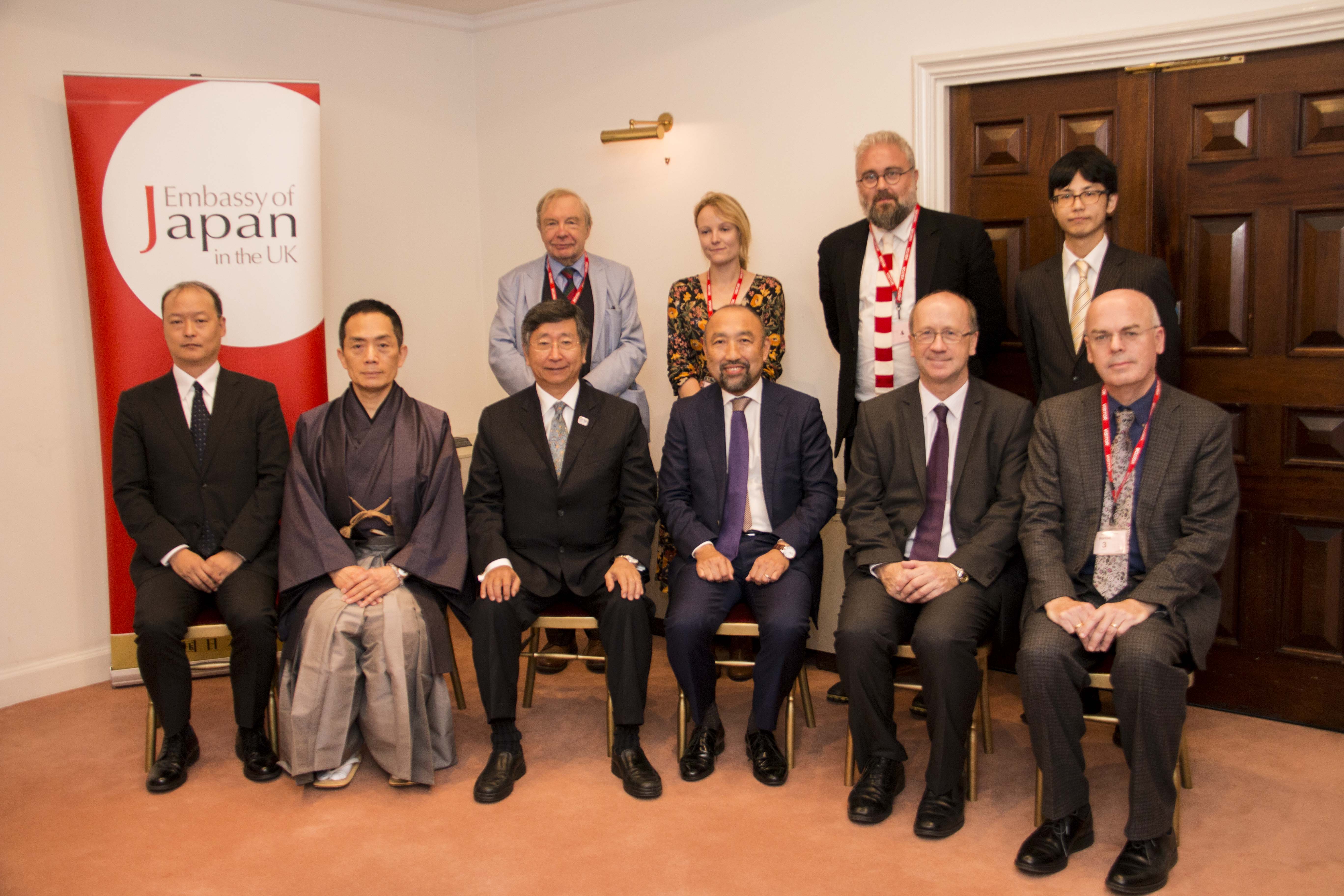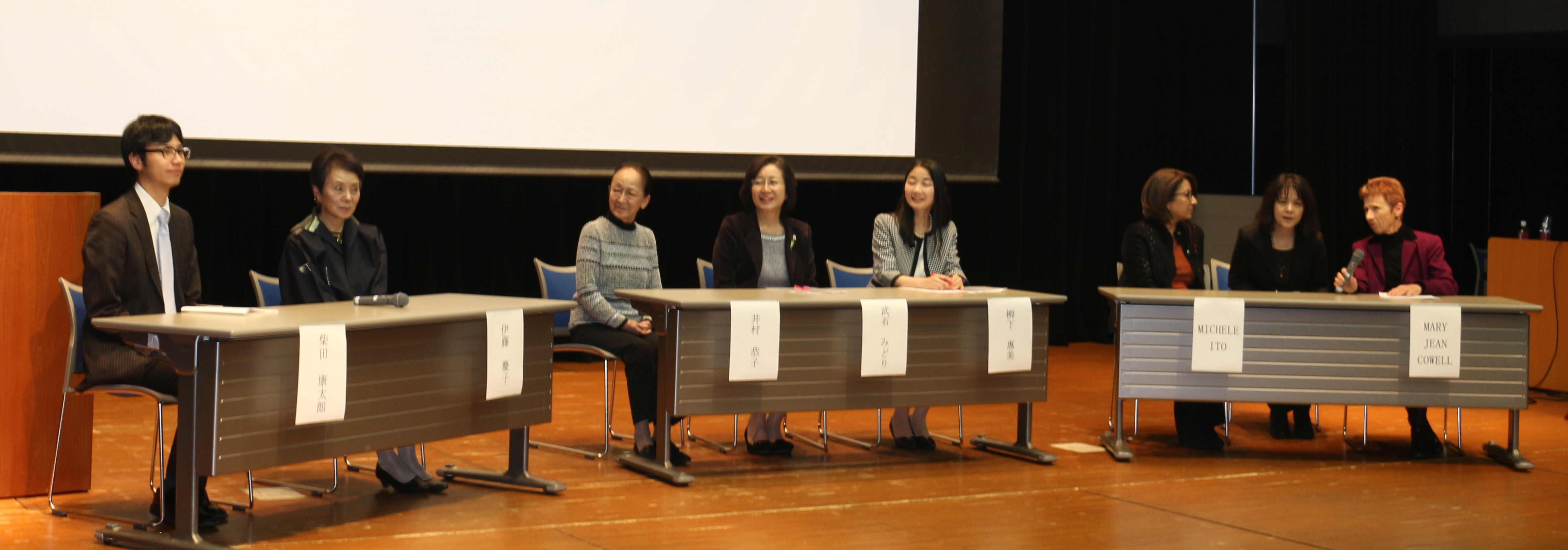Support Projects for Enhancing Function
Collaboration with Overseas Universities
and Fostering Next Generation
Fiscal 2017
The first project, “Collaboration with Overseas Universities and Fostering Next Generation,” involves partnering with world-renowned theater institutes to improve the way we communicate our research on a world stage. It also involves fostering the next generation of researchers. Accordingly, we participated in two international symposia and organized a program for dispatching young researchers.
UK International Symposium “Ninagawa Shakespeare: A Memorial Symposium” and Open Seminar
The Ninagawa Company staged a commemorative production of NINAGAWA Macbeth at London’s Barbican Centre in October 2017. Taking this production as an opportunity to deepen the collaborative partnership we began with the University of Birmingham’s Shakespeare Institute, we organized a seminar and international symposium on Ninagawa’s Shakespeare productions in Britain. During the seminar at the Shakespeare Institute on October 5, Ryuichi Kodama presented “Ninagawa Macbeth and Japanese Classical Theater” and Hiroko Yamaguchi of Asahi Shimbun presented “Yukio Ninagawa.” They discussed kabuki adaptations of Shakespeare works, the kabuki-esque elements in Ninagawa’s Macbeth, including the matter of onnagata (male actors who play female roles), and some of the distinctive features of the productions, such as the linkage of the inside with the outside of the theaters. Approximately 80 people attended the seminar, and an engaging Q&A session was held at the end.
Following this seminar, the international symposium “Ninagawa Shakespeare: A Memorial Symposium” was held at the Embassy of Japan in the UK on October 6. Approximately 100 people attended the symposium, and British and Japanese experts exchanged a wide range of ideas and opinions. The first part of the symposium, “Ninagawa Remembered,” featured four speakers: Professor Michael Dobson (Director of the Shakespeare Institute), a leading Shakespearean scholar; Michael Billington, one of the UK’s leading theater critics; Philip Breen, the spirited theater director; and Rosalind Fielding, an up-and-coming Shakespearean scholar. They discussed various topics regarding how Ninagawa is received in Britain: recollections on Macbeth in 1985, which renewed the image of Japanese theaters in the UK, Ninagawa’s syncretic nature that links the East and the West and the classical and the modern, and so on. Then Kotaro Shibata delivered a speech on “The Tsubouchi Memorial Theatre Museum and Shakespeare” in which he introduced the Theatre Museum, its relationship with Shakespeare, and the materials related to him. After this speech, the symposium moved to its second part: an interview session titled “A Kabuki Onnagata and Shakespeare.” In this, Professor Kodama conversed with Kyozo Nakamura, a kabuki actor who played one of the witches in the Barbican production of NINAGAWA Macbeth, on a range of topics, including memories from the rehearsal sessions with the director who was known to be strict, the personal experience of performing in the productions, and the significance and possibility of passing on these productions to successive generations.
During their stay in the UK, our team held discussions with British research and cultural institutes, such as SOAS University of London and the Globe Theatre, thereby, providing an important foothold for deepening our collaboration in the future.

Speakers at the international symposium (October 6, 2017)
International Symposium “Border-Crossing Dancer Michio Ito: His Memories, Materials and Research”
On November 11, 2017, we conducted an international symposium on “Border-Crossing Dancer Michio Ito: His Memories, Materials and Research” (held in the Ono Auditorium) to commemorate the release of the “Database of Materials Related to Michio Ito,” which is one of the project outcomes of the previous year. At the symposium, disciples, descendants, and scholars of Michio Ito engaged in multi-dimensional discussions about his pre-war activities in Britain and America and his remarkable post-war career in Japan.
The first part of the symposium was titled “Memories and Materials of Michio Ito.” Kotaro Shibata’s talk, “The Materials of Michio Ito in The Tsubouchi Memorial Theatre Having obtained a MEXT grant for the “Support for Enhancing Function” program, we are aiming to contribute to the development of theater and film studies through collaborating with overseas universities, fostering the next generation, and digitally archiving our materials so as to enhance the research environment. To this end, we are pursuing four projects. Museum Digital Archive Collection,” introduced our project, and he discussed the significance of developing a digital database of materials related to the dancer-choreographer. In the next lecture, “Introduction to Michio Ito and his Works and Methods,” Keiko Ito, Ito’s niece-in-law, spoke about her uncle’s life and displayed photographs from her family archives. Further, Kyoko Imura, Ito’s direct disciple, presented films of Taeko Furusho et al. to illustrate the dancer-choreographer’s “Ten Gestures,” introduced the works in which these gestures were applied, and outlined the unique method that characterized his productions. While Imura discussed the intergenerational handover of Ito’s works in Japan, the next speaker, Michele Ito, Ito’s biological grandson, described how his works have been handed down in America and how the memories of Ito?who had spent many years in America?have been transmitted and updated in the country.
The second part of the symposium, “Recent Studies of Michio Ito,” featured presentations in which scholars reported their latest findings. In her lecture, “The Starting Point of Dancer Michio Ito: From London to New York,” Midori Takeishi outlined the dancer-choreographer’s career in the West, focusing on his activities in London and New York. Emi Yagishita’s talk on “Michio Ito's International Artistic Activities: Establishing a Cultural Bridge Between East and West” multifacetedly analyzed his international activities in the U.S. and Japan. Marie-Jean Cowell presented “The Ongoing Significance of Michio Ito and His Work in the Contemporary Dance Landscape” in which she highlighted the significance that his dance method continues to enjoy in contemporary American dance and dance instruction.
In the past, research on Michio Ito has been hampered by a lack of materials, but the participants at the symposium exchanged a truly diverse array of perspectives. This symposium showed the significance of digitizing and releasing primary materials, as we have done with our database of materials related to Michio Ito, and its potential to bring in a greater range of perspectives and facilitate a richer exchange of these ideas between scholars in Japan and abroad to help the discipline flourish at a global level.

Spealers at the Symposium (November 11, 2018)
Dispatching Young Researchers Abroad Program
In 2017, we continued to encourage young researchers throughout Japan to participate in overseas research presentations. As part of this effort, we partially funded Ms. Mariko Kitahara’s trip to Ohio, USA, to deliver a presentation at the inaugural Dance Studies Association Conference titled “Transmissions and Traces: Rendering Dance” and hosted by the Ohio State University Department of Dance from October 19?22, 2017.
Kitahara delivered a presentation titled “When Did Fokine First See Duncan Dancing?: Examining a Historical Problematic.” Attended by 500 people from around the world, the conference was held to commemorate the merging of two key American dance organizations, the Society of Dance History Scholars and the Congress on Research in Dance, into the Dance Studies Association. As well as attending the conference, Kitahara surveyed the photographic works of Fokine at the New York Public Library.